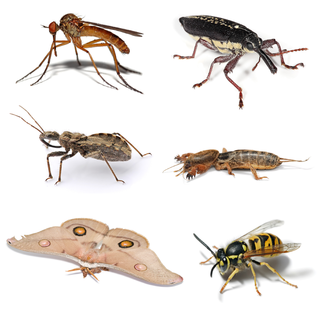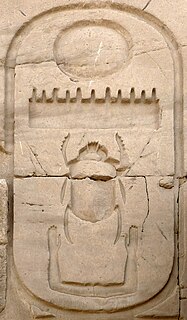 W
WEntomology is the scientific study of insects, a branch of zoology. In the past the term "insect" was vaguer, and historically the definition of entomology included the study of terrestrial animals in other arthropod groups or other phyla, such as arachnids, myriapods, earthworms, land snails, and slugs. This wider meaning may still be encountered in informal use.
 W
WA compound eye is a visual organ found in arthropods such as insects and crustaceans. It may consist of thousands of ommatidia, which are tiny independent photoreception units that consist of a cornea, lens, and photoreceptor cells which distinguish brightness and color. The image perceived by this arthropod eye is a combination of inputs from the numerous ommatidia, which are oriented to point in slightly different directions. Compared with single-aperture eyes, compound eyes have poor image resolution; however, they possess a very large view angle and the ability to detect fast movement and, in some cases, the polarization of light.
 W
WSeveral studies report a substantial decline in insect populations. Most commonly, the declines involve reductions in abundance, though in some cases entire species are going extinct. The declines are far from uniform. In some localities, there have been reports of increases in overall insect population, and some types of insects appear to be increasing in abundance across the world. A 2020 meta-analysis published in the journal Science found that globally, terrestrial insects appeared to be declining in abundance at a rate of about 9% per decade, while the abundance of freshwater insects has increased by 11% per decade.
 W
WDuring the 20th century, Deyrolle was a Parisian institution for natural sciences and pedagogy. It is one of the best known companies of entomology and taxidermy of Paris. Today, Deyrolle is a shop and a cabinet of curiosities open to the public, a reference in the field of taxidermy, entomology and natural sciences, whose vocation is to show the beauty of Nature. Deyrolle is also involved in pedagogy and art.
 W
WThis glossary of entomology describes terms used in the formal study of insect species by entomologists.
 W
WInsects or Insecta are hexapod invertebrates and the largest group within the arthropod phylum. Definitions and circumscriptions vary; usually, insects comprise a class within the Arthropoda. As used here, the term Insecta is synonymous with Ectognatha. Insects have a chitinous exoskeleton, a three-part body, three pairs of jointed legs, compound eyes and one pair of antennae. Insects are the most diverse group of animals; they include more than a million described species and represent more than half of all known living organisms. The total number of extant species is estimated at between six and ten million; potentially over 90% of the animal life forms on Earth are insects. Insects may be found in nearly all environments, although only a small number of species reside in the oceans, which are dominated by another arthropod group, crustaceans.
 W
WInsects have found uses in art, as in other aspects of culture, both symbolically and physically, from ancient times. Artforms include the direct usage of beetlewing (elytra) in paintings, textiles, and jewellery, as well as the representation of insects in fine arts such as paintings and sculpture. Insects have sometimes formed characteristic features of artforms, as in Art Nouveau jewellery.
 W
WInsects have appeared in literature from classical times to the present day, an aspect of their role in culture more generally. Insects represent both positive qualities like cooperation and hard work, and negative ones like greed.
 W
WInsects have long been used in medicine, both traditional and modern, sometimes with little evidence of their effectiveness. For the purpose of the article, and in line with custom, medicinal uses of other arthropods such as spiders are included.
 W
WInsect names have appeared in music from Rimsky-Korsakov's "Flight of the Bumblebee" to such popular songs as "Blue-tailed Fly" and the folk song La Cucaracha which is about a cockroach. Insect groups mentioned include bees, ants, flies and the various singing insects such as cicadas, crickets, and beetles, while other songs refer to bugs in general.
 W
WInsects have appeared in mythology around the world from ancient times. Among the insect groups featuring in myths are the bee, fly, butterfly, cicada, dragonfly, praying mantis and scarab beetle.
 W
WInsects have long been used in religion, both directly and as images or symbols.
 W
WThe Lincoln University Entomology Research Collection is a collection of approximately 500,000 insect, spider, and other arthropod specimens housed in Lincoln University, New Zealand. One of New Zealand's largest insect research collections, it is the only one based in a university.
 W
WThis is a list of songs inspired by insects.
 W
WEntomology, the scientific study of insects and closely related terrestrial arthropods, has been impelled by the necessity of societies to protect themselves from insect-borne diseases, crop losses to pest insects, and insect-related discomfort, as well as by people's natural curiosity. This timeline article traces the history of entomology.
 W
W1850Edmond de Sélys Longchamps Revue des odonates ou Libellules d'Europe. Mémoires de la Société Royale des Sciences de Liége 6:1–408. Victor Ivanovitsch Motschulsky Die Kaefer Russlands. I. Insecta Carabica. Russian beetles, Carabidae, Moscow: Gautier, published.
 W
W W
W